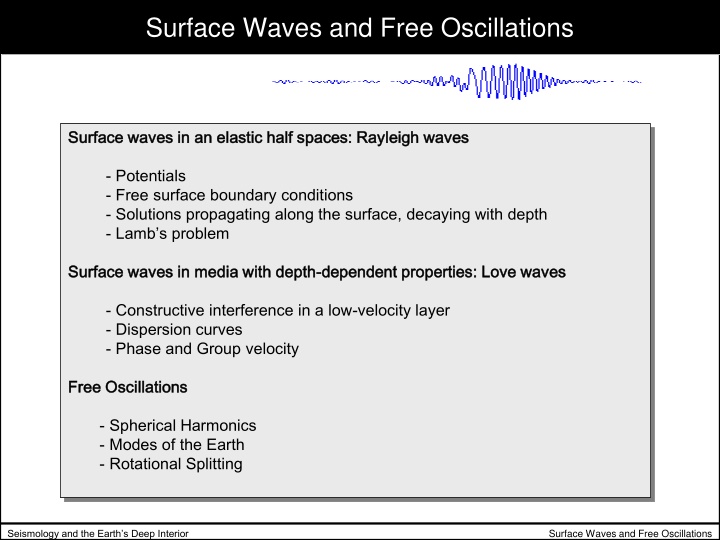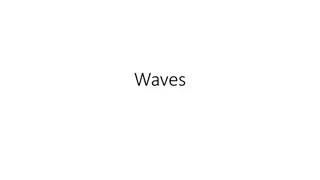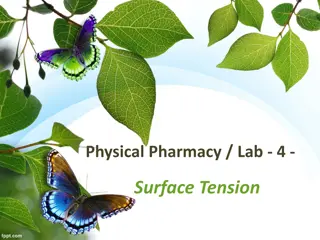Surface Waves and Free Oscillations in Seismology
Exploring surface waves, potentials, and free oscillations in seismology with a focus on Rayleigh waves, Love waves, and wave equations. Understand the dispersion relation, geometry, and solutions for waves propagating in elastic half spaces and media with depth-dependent properties.
Download Presentation

Please find below an Image/Link to download the presentation.
The content on the website is provided AS IS for your information and personal use only. It may not be sold, licensed, or shared on other websites without obtaining consent from the author.If you encounter any issues during the download, it is possible that the publisher has removed the file from their server.
You are allowed to download the files provided on this website for personal or commercial use, subject to the condition that they are used lawfully. All files are the property of their respective owners.
The content on the website is provided AS IS for your information and personal use only. It may not be sold, licensed, or shared on other websites without obtaining consent from the author.
E N D
Presentation Transcript
Surface Waves and Free Oscillations Surface waves in an elastic half spaces: Rayleigh waves Surface waves in an elastic half spaces: Rayleigh waves - Potentials - Free surface boundary conditions - Solutions propagating along the surface, decaying with depth - Lamb s problem Surface waves in media with depth Surface waves in media with depth- -dependent properties: Love waves dependent properties: Love waves - Constructive interference in a low-velocity layer - Dispersion curves - Phase and Group velocity Free Oscillations Free Oscillations - Spherical Harmonics - Modes of the Earth - Rotational Splitting Surface Waves and Free Oscillations Seismology and the Earth s Deep Interior
The Wave Equation: Potentials Do solutions to the wave equation exist for an elastic half space, which travel along the interface? Let us start by looking at potentials: These potentials are solutions to the wave equation = ( + , ) u = 2 2 2 i t = , = 2 2 2 x y z t i i u displacement P-wave speed i scalar potential Shear wave speed vector potential i What particular geometry do we want to consider? Surface Waves and Free Oscillations Seismology and the Earth s Deep Interior
Rayleigh Waves SV waves incident on a free surface: conversion and reflection An evanescent P-wave propagates along the free surface decaying exponentially with depth. The reflected post-crticially reflected SV wave is totally reflected and phase-shifted. These two wave types can only exist together, they both satisfy the free surface boundary condition: -> Surface waves Surface Waves and Free Oscillations Seismology and the Earth s Deep Interior
Surface waves: Geometry We are looking for plane waves traveling along one horizontal coordinate axis, so we can - for example - set (.) = y 0 And consider only wave motion in the x,z plane. Then = u Wavefront x x z y y = + u z z x y x As we only require y we set y= from now on. Our trial solution is thus = exp[ ( )] A ik ct az x z Surface Waves and Free Oscillations Seismology and the Earth s Deep Interior
Surface waves: Dispersion relation With this trial solution we obtain for example coefficients a for which travelling solutions exist 2 c = 1 a 2 In order for a plane wave of that form to decay with depth a has to be imaginary, in other words c Together we obtain = 2 2 exp[ ( / 1 )] A ik ct c z x = 2 2 exp[ ( / 1 )] B ik ct c z x So that c Surface Waves and Free Oscillations Seismology and the Earth s Deep Interior
Surface waves: Boundary Conditions Analogous to the problem of finding the reflection-transmission coefficients we now have to satisfy the boundary conditions at the free surface (stress free) = = 0 xz zz In isotropic media we have = + + 2 = ( ) u u u u zz x x z z z z x x z y where = 2 u = + u xz x z z z x y and = 2 2 exp[ ( / 1 )] A ik ct c z x = 2 2 exp[ ( / 1 )] B ik ct c z x Surface Waves and Free Oscillations Seismology and the Earth s Deep Interior
Rayleigh waves: solutions This leads to the following relationship for c, the phase velocity: = 2 2 2 2 2 / 1 ) 2 2 2 / 1 ) 2 2 ( / ) 1 ( 4 / 1 ( / c c c For simplicity we take a fixed relationship between P and shear- wave velocity 3 = to obtain + = 6 6 4 4 2 2 / 8 / 56 / 3 / 32 / 2 0 c c c c and the only root which fulfills the condition is 9194 . 0 = c Surface Waves and Free Oscillations Seismology and the Earth s Deep Interior
Displacement Putting this value back into our solutions we finally obtain the displacement in the x-z plane for a plane harmonic surface wave propagating along direction x 8475 . 0 3933 . 0 = kz kz ( . 0 5773 ) sin ( ) u C e e k ct x x 8475 . 0 3933 . 0 = . 0 . 1 + kz kz ( 8475 4679 ) cos ( ) u C e e k ct x z This development was first made by Lord Rayleigh in 1885. It demonstrates that YES there are solutions to the wave equation propagating along a free surface! Some remarkable facts can be drawn from this particular form: Surface Waves and Free Oscillations Seismology and the Earth s Deep Interior
Lambs Problem theoretical -the two components are out of phase by p - for small values of z a particle describes an ellipse and the motion is retrograde - at some depth z the motion is linear in z - below that depth the motion is again elliptical but prograde - the phase velocity is independent of k: there is no dispersion for a homogeneous half space experimental - the problem of a vertical point force at the surface of a half space is called Lamb s problem (after Horace Lamb, 1904). - Right Figure: radial and vertical motion for a source at the surface Surface Waves and Free Oscillations Seismology and the Earth s Deep Interior
Particle Motion (1) How does the particle motion look like? theoretical experimental Surface Waves and Free Oscillations Seismology and the Earth s Deep Interior
Particle motion Surface Waves and Free Oscillations Seismology and the Earth s Deep Interior
Data Example theoretical experimental Surface Waves and Free Oscillations Seismology and the Earth s Deep Interior
Data Example Question: We derived that Rayleigh waves are non-dispersive! But in the observed seismograms we clearly see a highly dispersed surface wave train? We also see dispersive wave motion on both horizontal components! Do SH-type surface waves exist? Why are the observed waves dispersive? Surface Waves and Free Oscillations Seismology and the Earth s Deep Interior
Love Waves: Geometry In an elastic half-space no SH type surface waves exist. Why? Because there is total reflection and no interaction between an evanescent P wave and a phase shifted SV wave as in the case of Rayleigh waves. What happens if we have layer over a half space (Love, 1911) ? Surface Waves and Free Oscillations Seismology and the Earth s Deep Interior
Love Waves: Trapping Repeated reflection in a layer over a half space. Interference between incident, reflected and transmitted SH waves. When the layer velocity is smaller than the halfspace velocity, then there is a critical angle beyon which SH reverberations will be totally trapped. Surface Waves and Free Oscillations Seismology and the Earth s Deep Interior
Love Waves: Trapping The formal derivation is very similar to the derivation of the Rayleigh waves. The conditions to be fulfilled are: 1. 2. 3. Free surface condition Continuity of stress on the boundary Continuity of displacement on the boundary Similary we obtain a condition for which solutions exist. This time we obtain a frequency-dependent solution a dispersion relation 2 / 1 2 / 1 c 2 2 / 1 = 2 2 tan( / 1 ) H c 1 / 1 2 2 / 1 c 1 1 ... indicating that there are only solutions if ... c 1 2 Surface Waves and Free Oscillations Seismology and the Earth s Deep Interior
Exercise Result 4500 4400 4300 4200 Phase velocity (m/s) 4100 4000 3900 3800 3700 3600 3500 0 10 20 30 40 Period (s) 50 60 70 80 90 Surface Waves and Free Oscillations Seismology and the Earth s Deep Interior
Love Waves: Solutions Graphical solution of the previous equation. Intersection of dashed and solid lines yield discrete modes. Is it possible, now, to explain the observed dispersive behaviour? Surface Waves and Free Oscillations Seismology and the Earth s Deep Interior
Love Waves: modes Some modes for Love waves Surface Waves and Free Oscillations Seismology and the Earth s Deep Interior
Waves around the globe Surface Waves and Free Oscillations Seismology and the Earth s Deep Interior
Stacks Surface Waves and Free Oscillations Seismology and the Earth s Deep Interior
Phase and group velocity Surface Waves and Free Oscillations Seismology and the Earth s Deep Interior
Dispersion The typical dispersive behavior of surface waves solid group velocities; dashed phase velocities Surface Waves and Free Oscillations Seismology and the Earth s Deep Interior
Love wave dispersion Surface Waves and Free Oscillations Seismology and the Earth s Deep Interior
Love wave dispersion Surface Waves and Free Oscillations Seismology and the Earth s Deep Interior
Love wave dispersion Surface Waves and Free Oscillations Seismology and the Earth s Deep Interior
Love wave dispersion Surface Waves and Free Oscillations Seismology and the Earth s Deep Interior
Love waves, rotations and translations Surface Waves and Free Oscillations Seismology and the Earth s Deep Interior
Love waves, rotations and translations Surface Waves and Free Oscillations Seismology and the Earth s Deep Interior
Higher mode Love waves Surface Waves and Free Oscillations Seismology and the Earth s Deep Interior
Observed Phase and Group Velocities Surface Waves and Free Oscillations Seismology and the Earth s Deep Interior
Group velocity maps 35-second Love wave group velocity map of perturbations with respect to PREM Larson and Ekstrom 2001 Surface Waves and Free Oscillations Seismology and the Earth s Deep Interior
Surface wave paths Surface Waves and Free Oscillations Seismology and the Earth s Deep Interior
Tohoku-oki M9.0 Surface Waves and Free Oscillations Seismology and the Earth s Deep Interior
Other data representation Surface Waves and Free Oscillations Seismology and the Earth s Deep Interior
Free oscillations - Data 20-hour long recording of a gravimeter recordind the strong earthquake near Mexico City in 1985 (tides removed). Spikes correspond to Rayleigh waves. Spectra of the seismogram given above. Spikes at discrete frequencies correspond to eigenfrequencies of the Earth Surface Waves and Free Oscillations Seismology and the Earth s Deep Interior
Spectra Surface Waves and Free Oscillations Seismology and the Earth s Deep Interior
Principle of modes on a string Fundamental mode and overtones Surface Waves and Free Oscillations Seismology and the Earth s Deep Interior
Examples Surface Waves and Free Oscillations Seismology and the Earth s Deep Interior
Naming convention of modes Surface Waves and Free Oscillations Seismology and the Earth s Deep Interior
Mode names m l S n spheroidal m T toroidal n l n - zero-crossings in depth l - angular order overall zero crossings on surface m - azimuthal order zero crossings through pole Surface Waves and Free Oscillations Seismology and the Earth s Deep Interior
Spherical harmonics Surface Waves and Free Oscillations Seismology and the Earth s Deep Interior
OS2 T=54 mins Surface Waves and Free Oscillations Seismology and the Earth s Deep Interior
Eigenmodes of a sphere Eigenmodes of a homogeneous sphere. Note that there are modes with only volumetric changes (like P waves, called spheroidal) and modes with pure shear motion (like shear waves, called toroidal). - pure radial modes involve no nodal patterns on the surface - overtones have nodal surfaces at depth - toroidal modes involve purely horizontal twisting - toroidal overtones have nodal surfaces at constant radii. Surface Waves and Free Oscillations Seismology and the Earth s Deep Interior
Energy of modes at depth Surface Waves and Free Oscillations Seismology and the Earth s Deep Interior
Free oscillations Torsional mode, n=0, =5, |m|=4. period 18 minutes Source: http://icb.u-bourgogne.fr/nano/MANAPI/saviot/terre/index.en.html Surface Waves and Free Oscillations Seismology and the Earth s Deep Interior
Modes and their meaning Surface Waves and Free Oscillations Seismology and the Earth s Deep Interior
Modes and their meaning Surface Waves and Free Oscillations Seismology and the Earth s Deep Interior
Equations for free oscillations Surface Waves and Free Oscillations Seismology and the Earth s Deep Interior
The Earths Eigenfrequencies Surface Waves and Free Oscillations Seismology and the Earth s Deep Interior























